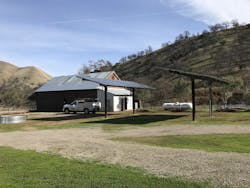Microgrid Dreaming: California Gov. Brown Makes it Real at his Ranch
Who knew he was envisioning his own home when three years ago in his inaugural address California Gov. Jerry Brown described a future with microgrids.
In a walk-the-talk move, Brown now has a solar plus storage microgrid serving his new home, a ranch north of Sacramento.
Brown needed the microgrid for the same reason 1.4 billion others in the world need microgrids. The isolated home had no access to an electric grid.
“Given his leadership in connection with climate change and renewable energy, one would expect Gov. Brown to embrace solar+storage to power his home,” said Catherine Von Burg, CEO of SimpliPhi Power, a California company that supplied the batteries. “But this microgrid was also motivated by an all-too-common reality: the electrical infrastructure serving the ranch’s location in Colusa County simply didn’t exist.”
The Brown Ranch microgrid has 48 solar panels, which produce 14 kWh, feeding renewable power into three OutBack Radian GS8048A inverter/chargers and 10 SimpliPhi PHI 3.4 kWh, 48V batteries.
Catherine Von Burg is among the C-suite executives who will speak at Microgrid 2018. Join us May 7-9 in Chicago.
During his inaugural address in January 2015, Gov. Brown called for more energy efficiency, microgrids and distributed generation to cut greenhouse gases.
“I envision a wide range of initiatives: more distributed power, expanded rooftop solar, microgrids, an energy imbalance market, battery storage, the full integration of information technology and electrical distribution and millions of electric and low-carbon vehicles,” Brown said at the time.
Now California is a leading state for microgrids, and this year alone announced grants totaling about $50 million to help spur commercialization of the technology. The state also is drawing up a roadmap to help realize its microgrid vision.
Since the Brown ranch is not connected to the grid, the microgrid includes backup in the form of a 24-kWh natural gas generator to keep the power flowing when sunlight is scarce.
Remote microgrids like the one found at the ranch are less common in the U.S. than grid-connected microgrids, which operate in concert with the utility grid — they exchange services with the grid based on optimal cost, emissions, or other parameters set by the microgrid controller. During an outage, a grid-connected microgrid disengages — or islands — from the grid and serves its customers via its onsite generators. Because it has no grid connection, the Brown Ranch microgrid operates in this islanded mode at all times. Remote microgrids are commonly found in rural outposts, islands, and places that lack electric grids, such as parts of Africa and Asia.
PRNewsfoto/SimpliPhi Power
Jason Andrade of West Coast Sustainables, who designed the Brown Ranch microgrid said he chose a combination of SimpliPhi batteries and OutBack Power inverters because they allowed for easy system expansion when future ranch improvements demand more power – “and because we trust the proven track record of both companies.”
Brandon Provalenko, vice president of commercial operations at OutBack Power said that the microgrid provides “a compelling case study for the cost effectiveness and viability of renewable energy plus storage in providing reliable off-grid power.”
Read more about remote microgrids by subscribing to the free Microgrid Knowledge newsletter.
About the Author
Elisa Wood
Editor-in-Chief
Elisa Wood is the editor and founder of EnergyChangemakers.com. She is co-founder and former editor of Microgrid Knowledge.
